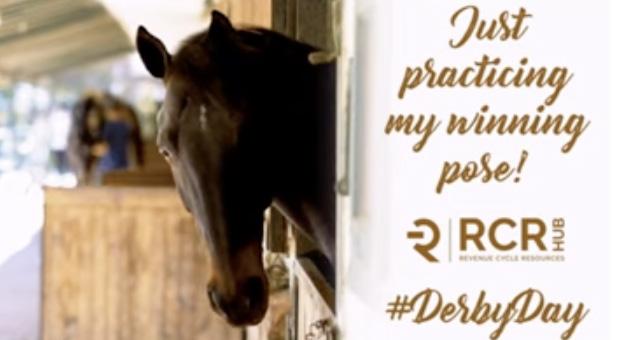





 JENA R. EGGERT
CEO & Founder RCR|HUB and JER Marketing
JENA R. EGGERT
CEO & Founder RCR|HUB and JER Marketing







 JENA R. EGGERT
CEO & Founder RCR|HUB and JER Marketing
JENA R. EGGERT
CEO & Founder RCR|HUB and JER Marketing
Flipping through the RCM editorial calendar, I spotted the May date and immediately thought of the Derby! With the 150th running upon us, it felt like the perfect time to bring some Derby fun to our CommUnity.
After all, as they say, it’s the “greatest two minutes in sports!”


As a proud University of Kentucky grad (LEX), I found the celebration of Derby and its events fantastic! Looking back at pictures for this issue, I had to laugh at the hats and outfits—who can forget the COVID toilet paper and bourbon stockpiles? (Honestly, which was more coveted?) But I digress...
On an RCM note, this issue explores the amazing health systems that make up the Bluegrass. Big thanks to all our sponsors who loosened the reins and got creative with their ads—they’re fantastic!
This issue contains a “sme insight” section! A huge shoutout to Zane for making this happen. And guess what? There’s one more exclusive announcement hiding inside – but you’ll have to grab your mouse and start turning pages to find out!
Win, Place, or Show-Enjoy the Roses!


 Jena Eggert Editor-in-Chief
RCM Connections
Jena Eggert Editor-in-Chief
RCM Connections
DEMOGRAPHICS
EXPLORING THE PULSE OF KENTUCKY HOSPITAL LIFE
01. 06. 09.
SPECIAL ARTICLE
CHAMPING AT THE BIT TO REACH THE WINNER’S CIRCLE? USE THESE METHODS TO REIN IN PAYERS AND SPEED UP CASH
12.
CELEBRATING RETIREMENT TOM YOESLE
14.
SHAKERS & MOVERS
70 PEOPLE WHO CHANGED THEIR JOBS




There’s a better revenue cycle around the turn . Why the long face? With SparkChange you can accelerate your reimbursement process to the finish line with analytics, automations, and a full suite of services designed to meet your needs. Don’t let denials ride you off the rails. It’s time to pony up and find a sustainable solution to your challenges.



The annual Kentucky Derby approaches and with it a focus on agility, strategy and paramount; speed.
For Revenue Cycle Leaders, the Kentucky Derby isn’t yearly. It’s monthly, and the mission is always the same. And always twofold:
“Maximize Cash and Move it From the Payer’s Bank to Our Bank As Fast as You Can!”
This article focuses on the latter, namely, how to rapidly increase the speed at which Cash can accelerated within a complex, voluminous and unforgiving Accounts Receivable.
BY: ZANE NEWITT Chief Executive OfficerExcalibur Data Driven Performance Management

The objective of the Revenue Cycle Operations Team is the rapid, accurate and compliant conversion of Gross Revenue into Cash at a sustainable speed equal to or greater than an established prior period of Net Revenue. But, whereas Cash management involves maximizing reimbursement, contract compliance, Denial prevention and “not leaving any dollars on the table’, the management of the Receivable has more to do with the art of resolving more balances in the right hand than new
volumes pouring into the left. If the Resolution : Gross Revenue Ratio is greater than 100.1%, and sound cash collection methods are enculturated, then Cash acceleration is typically the result. Receivable management is about speed and the by-product of resolving accounts more rapidly is the acceleration of Cash that accompanies a more strategic approach to resolving a higher volume of accounts, faster. These four strategies will guide our Revenue Cycle Jocks in beating their peers, and more importantly, the Payers, to the finish line.
Working Accounts Due for Follow Up “Today” Hiding within the Receivable (regardless of the size or type of facility or system, the variables within any Accounts Receivable in the industry are voluminous and overwhelming) is a pocket of fresh A/R that should receive prioritized follow-up efforts.
How is this golden pocket found?
Cash is collected ‘today’ on volumes that were generated “prior to today’. For this reason, the principle of understanding Lagging Gross/Net Revenue is the first fundamental of revenue cycle management. Rather than organizing the A/R by Age or overly obsessing over Balance, the AR should be viewed as a funnel of new accounts that have an Expected Resolution Date that is Payer Specific.
For example; Medicare has no lag. Medicare balances ‘born last month should process this month’ whereas Work Comp accounts ‘born last month won’t process for three months.’ Having command of this principle allows for the creation of a Lagging Revenue, which is more important than both current month Gross Revenue and Aged A/R, and represents the exact accounts that should be attacked ‘right now’. In fact, the Aged or distressed portions of the Receivable only exist due to a failure to allow too much leakage, payer stalls and lack of attention of liquidating
the accounts actually due for a touch ‘this month.’
Implementation Tips: For organizations that lack a robust analytics platform, develop a Lagging Revenue table at the summary level such as :
• Medicare – 0 Month Lag, Use Prior Month Gross Rev for Current Month Resolution Expectation
• Blue Cross – 1 Month Lag with 2 Months Average
• Medicare Managed Care – 1 Month Lag with 2 Months Average
From here, simply sum the Total Charges on Accounts that fall within the Lag Period. These are the accounts to go after ‘in this Period’.
For organizations with an analytics platform, assign an ‘Expected Claim Resolution Date’ at the account level that is Payer specific. Simply sum the Total Charges on these claims and isolate them as the precise pocket of A/R to tackle “this month” or “right now”
The most important touch in AR Management is the first follow up effort. If performed too soon, not only is it a waste of between $2 and $3.25 (depending upon region and staffing costs), it allows the Payer to provide the non-results oriented “In Process, Too Soon to Obtain Status” defense, and then programmatically put the Provider’s claims at the bottom of the adjudication queue.
Because the Lagging Revenue or “Expected Resolution Date” is known, at the Payer level, it makes no sense to work an account too soon, or let it age. Rather, use Bot technology and a simple matrix to remove a human first-touch and let the Bot disposition the account, setting the plate for staff to use their energy and skill set where it is needed.
Important Tip: Do not configure Bot
technology to repetitiously ping Payer portals. This results in cost with no benefit, raises flags within the Payer’s adjudication algo rhythms, and may accidentally over-ride or supplant the Status or Disposition already applied on the account by a Patient Account Representative. The value of a Bot is to replace a human touch, reallocating the human to more meaningful work. If it’s not logical for a human to ping Blue Cross 8 days in a row for a status, then it’s not logical for the Bot either.
The Disposition is the ‘mood’ or story of the A/R. Some small percentage of the golden pocket of accounts due for a touch ‘this month, right now’ will suffer Denials, under-payments and stalls.
When focusing on speed, and although Dispositional Receivable Management allows for a segmented approach to managing the entire A/R efficiently, “let those go”.. for now. Instead, now broaden the scope and use the Dispositional Method to find other, older accounts that have a higher potential for conversion. Remember, an account that is 104 days old in a Promise to Pay Disposition is more valuable than an account that is 11 days old with an Open Complex Denial.
Winning the monthly derby often requires knowing what to let go, and what to go after.
Implementation Tip: If your organization doesn’t manage the A/R by Disposition with rigor and discipline, then you have limited insight into how the Receivable is behaving. Start with a library of status codes (i.e. Pended – Med Records Request, Denied – Timely Filing) and roll the statuses up to management level Dispositions such as “Pended, Denied, Promise to Pay”. Try to keep the list of statuses between 70 and 100 to not overwhelm the team, and make sure that the statuses are statuses, not “actions” as
the purpose is to know where an Account sits in the cycle, not whether or not a fax was sent etc.
Lastly, Revenue Cycle Leaders are seeing an overall change to the optics of the Receivable, Key Performance Indicators that don’t quite make business sense and anomalies that render month end a painful six (or even ten) day analytical nightmare. When unlayered, the root problem is that there are no longer just “high dollar” accounts that are headaches for the team, but “massive, ginormous balances” that can easily exceed $1M per claim! These “ginormous balances” are really a separate A/R hiding within the regular A/R. If removed from the Receivable and recasting is performed, the “regular A/R” is performing at 40 Days in Revenue Outstanding, but these claims are taking 120 (or more) days to resolve.
For speed of resolution, remove these from the Patient Account Representative’s ‘regular’ workflow altogether and consider a proactive approach (sending records with the claim, engaging an attorney upfront, talking to the Payer while the patient is in-house and even involving the CFO at the beginning of the cycle). Compressing the Adjudication Cycle for ‘ginormous balances’ is an entirely separate art and strategy than the normal race for cash, and the organization should align accordingly.
By calibrating the prior period volumes, at a Payer level, due for intervention ‘today’, by using Bots to set the plate by touching them at the right time, and with the right frequency, by understanding the liquidity of the A/R through the discipline of Dispositional Receivables Management, and my removing ginormous balances from the regular flow, your organization will rein in misbehaving payers, and win the Kentucky Cash Derby, every month.
https://excalibur-ddpm.com/
Over this two-day period, which includes both Kentucky Oaks and Kentucky Derby, around 120,000 Mint Juleps are typically served at Churchill Downs Racetrack

https://www.kentuckyderby.com/derby-horses/
Attendance for the 2024 Kentucky sources suggesting closer to
• Milestone Race: This year marks special anniversary that might
• New Paddock: Churchill Downs with luxury seating areas, potentially past winners have had names beginning with the letter “S,” including Secretariat. The Derby has never been cancelled or postponed due to inclement weather.

https://www.kentuckyderby.com/derby-horses/
Downs recently unveiled a new $200 million dollar paddock potentially attracting more high-rollers to the event. lbs is the weight of the Kentucky Derby trophy
The amount of food consumed at the Derby is pretty astounding. On average, spectators will eat 142,000 hot dogs, 18,000 barbecue sandwiches, 13,800 pounds of beef, 32,400 jumbo shrimp, 9,000 scallops, 8,000 pounds of potatoes, 30,000 cookies and 300,000 strawberries.
Kentucky Derby is expected to be well over 100,000 with some 150,000 [whas11.com]. This is due to a few reasons: marks the 150th running of the Kentucky Derby, making it a might draw a larger crowd.



About 38 years ago I stepped into my first healthcare job, working as a Food Service Specialist in a long term care center. My wonderful Mom thought this would be a good place for me to start working, plus she worked there on the clinical side and likely thought she’d be able to keep an eye on me.
To a teenager, understanding compassion and empathy can be tough. Put that same teenage in an environment where people need help, where the smallest gesture of kindness can change someone’s day, and you might just create a turning point for that teenager. That’s what happened to me. I learned that kindness can take all forms, from large audacious community initiatives, to simply listening and acknowledging someone’s story.
In March I announced my retirement, 38 years after taking that job in the cafeteria of an LTAC. During my career I had the honor to work at Orlando Health, after my amazing wife said “Hey, you should work there!”. That 25 year journey at Orlando Health took me from a Medical Records

Specialist in the basement (Thank you Juana Colon!) to the Chief Revenue Officer. At Orlando Health I worked with a team of the best RCM experts I’ve ever encountered. Keith Eggert, Craig Pergrem, Bridget Walters and Michelle Farrell to name a few. They set the benchmark for industry standards and consistently drove improvements through insight and collaboration….simply amazing people. For the last nearly 10 years I had the privilege to work with patients, colleagues and clients at HCA/Parallon as the Chief Experience Officer. I grew to understand the scale of one of the largest healthcare providers in the country and that even with that scale, the simple act of caring is often what our patients, colleagues and clients desired.
It has been an amazing 38 year journey of learning and as I move into my next chapter, I hope what I learned 38 years ago in that LTAC can guide my path forward.




